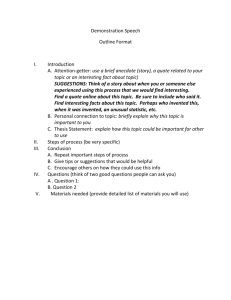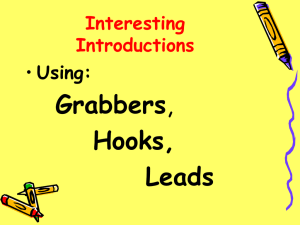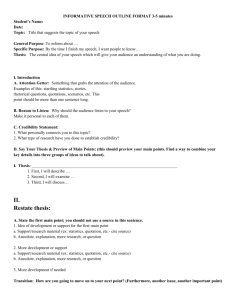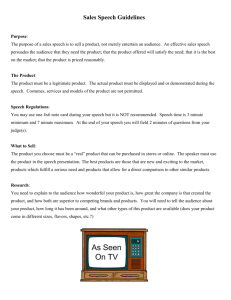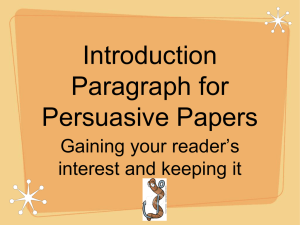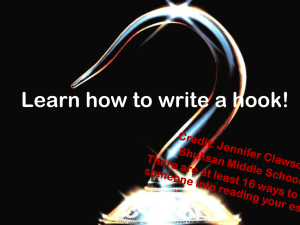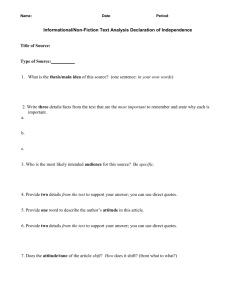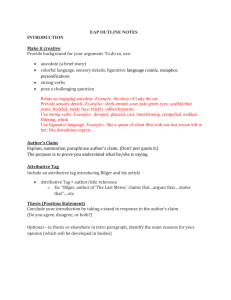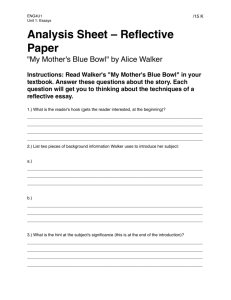Speech Writing Guide: Introduction, Body, Conclusion
advertisement
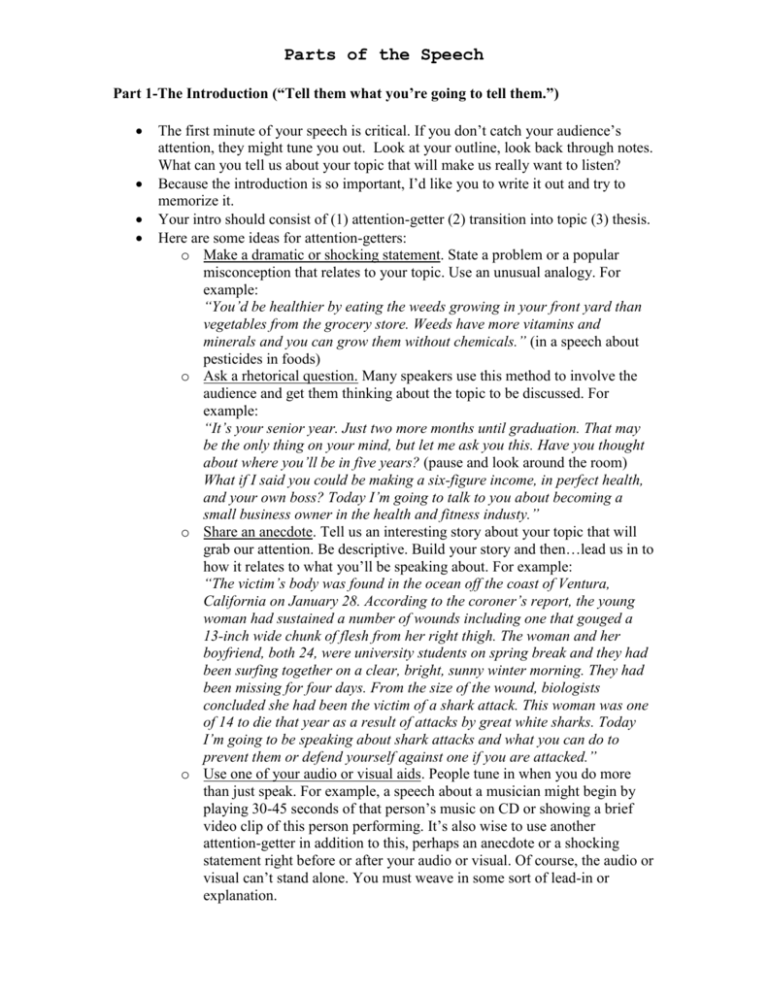
Parts of the Speech Part 1-The Introduction (“Tell them what you’re going to tell them.”) The first minute of your speech is critical. If you don’t catch your audience’s attention, they might tune you out. Look at your outline, look back through notes. What can you tell us about your topic that will make us really want to listen? Because the introduction is so important, I’d like you to write it out and try to memorize it. Your intro should consist of (1) attention-getter (2) transition into topic (3) thesis. Here are some ideas for attention-getters: o Make a dramatic or shocking statement. State a problem or a popular misconception that relates to your topic. Use an unusual analogy. For example: “You’d be healthier by eating the weeds growing in your front yard than vegetables from the grocery store. Weeds have more vitamins and minerals and you can grow them without chemicals.” (in a speech about pesticides in foods) o Ask a rhetorical question. Many speakers use this method to involve the audience and get them thinking about the topic to be discussed. For example: “It’s your senior year. Just two more months until graduation. That may be the only thing on your mind, but let me ask you this. Have you thought about where you’ll be in five years? (pause and look around the room) What if I said you could be making a six-figure income, in perfect health, and your own boss? Today I’m going to talk to you about becoming a small business owner in the health and fitness industy.” o Share an anecdote. Tell us an interesting story about your topic that will grab our attention. Be descriptive. Build your story and then…lead us in to how it relates to what you’ll be speaking about. For example: “The victim’s body was found in the ocean off the coast of Ventura, California on January 28. According to the coroner’s report, the young woman had sustained a number of wounds including one that gouged a 13-inch wide chunk of flesh from her right thigh. The woman and her boyfriend, both 24, were university students on spring break and they had been surfing together on a clear, bright, sunny winter morning. They had been missing for four days. From the size of the wound, biologists concluded she had been the victim of a shark attack. This woman was one of 14 to die that year as a result of attacks by great white sharks. Today I’m going to be speaking about shark attacks and what you can do to prevent them or defend yourself against one if you are attacked.” o Use one of your audio or visual aids. People tune in when you do more than just speak. For example, a speech about a musician might begin by playing 30-45 seconds of that person’s music on CD or showing a brief video clip of this person performing. It’s also wise to use another attention-getter in addition to this, perhaps an anecdote or a shocking statement right before or after your audio or visual. Of course, the audio or visual can’t stand alone. You must weave in some sort of lead-in or explanation. PART 2 – The Body (“Now, tell them.”) Write a phrase outline to guide you as you speak. Every point you make should be part of your outline. There’s no “winging it” allowed for this speech. You must have a phrase outline in order to give your speech. Do not write out the body of your speech word for word. Here are a few hints for writing your outline: o Be logical. Think about the best way to convey your information and do so logically so that your audience can easily follow you. o Be concise. You only have 5-7 minutes so don’t try to tell us everything about a subject. Refer back to your thesis, and keep your focus. o Cite your sources. We’re a smart audience and we want to know where you’ve gotten your information. If you give us a statistic or cite a study, for example, be sure to tell us where you got your information. o Use examples, anecdotes, and personal connections to keep us interested and attentive. People are interested about people. For example, you could tell us that many people die each year from smoking-related illnesses, but it’s hard for us to care about “many.” How about giving us an actual number or follow your statistic with a specific anecdote about someone who was personally affected. Tell us some stories, too. o Be descriptive. Include opportunities in your speech to really paint a picture for your listeners. Help us visualize a situation or understand how something works. o Use examples. Either use (and cite, of course) examples from your research or examples from your own life. Listeners really enjoying hearing examples that drive home a point or make an idea clear. They add a human and emotional touch to the speech. PART 3 –The Conclusion (“Tell them what you told them.”) o A strong, well-formed conclusion brings your speech to a satisfying end for your audience. A weak conclusion can ruin a good speech. Never just say, “Well, that’s pretty much it…” Or “Ok, I’m done…”A great way to end any speech is to tie your conclusion back to the introduction. Refer back to that shocking statistic or that anecdote you told earlier. Remind us of the reason we tuned into you in the first place. And finally…pause for a moment and simply say “thank you.” o Again, as you did in your intro, I’d like you to write out your conclusion and try to memorize it. A strong conclusion will do the following: o Remind the audience of the importance of the information you’ve shared. You may want to use a different attention-getter to accomplish that or even refer back to the one you used in your introduction for added effect. o Summarize your thesis and your main points. You may want to use a visual to help you do this.
